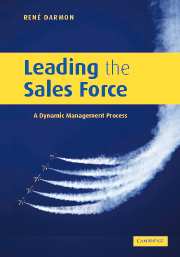Book contents
- Frontmatter
- Contents
- List of figures
- List of tables
- Preface
- 1 Introduction to the dynamic management process
- Part I The actors in the process and their roles
- 2 Buyers: key actors in the process
- 3 Dynamic customer relationship management processes
- 4 Salespeople: intermediaries in the dynamic management process
- 5 Sales managers: leaders of the dynamic management process
- 6 The changing environment of the dynamic management process
- Part II Tools for implementing the process: the command center
- Conclusion
- References
- Index
2 - Buyers: key actors in the process
from Part I - The actors in the process and their roles
Published online by Cambridge University Press: 27 October 2009
- Frontmatter
- Contents
- List of figures
- List of tables
- Preface
- 1 Introduction to the dynamic management process
- Part I The actors in the process and their roles
- 2 Buyers: key actors in the process
- 3 Dynamic customer relationship management processes
- 4 Salespeople: intermediaries in the dynamic management process
- 5 Sales managers: leaders of the dynamic management process
- 6 The changing environment of the dynamic management process
- Part II Tools for implementing the process: the command center
- Conclusion
- References
- Index
Summary
A salesperson's constant fear: the unexpected loss of a key account
Jim Harris, one of the most appreciated salespeople employed by the Heavy Duty Division (HDD) of an international manufacturer of automotive products had been negotiating an important contract for some time. This involved the replacement of the larger part of the truck fleet at a major transport company, a long-term client of the truck manufacturer's division. The contract involved the sale of about 200 vehicles, to be delivered over a six-month period. The deal was estimated at several billion euros. Two suppliers had made it to the last round of negotiations for this important contract, and discussions were tight. The customer's choice was going to be made on essentially economic criteria. A key decision criterion used by Tom Hilton, the procurement manager, was the transportation cost of one ton of goods per one hundred kilometers. These costs included operating and maintenance costs as well as the depreciation costs of the vehicles over their life expectancy.
Jim was about to obtain the contract. Although the offer was quoted at a price somewhat higher than most of the competing offers, the price premium could be explained by the high engineering quality of their trucks and by the strong reputation the firm enjoyed in this market. The vehicles' average life expectancy was substantially longer than those of competing trucks, and maintenance costs over a truck's expected life were considered lower for the HDD products.
- Type
- Chapter
- Information
- Leading the Sales ForceA Dynamic Management Process, pp. 29 - 53Publisher: Cambridge University PressPrint publication year: 2006

